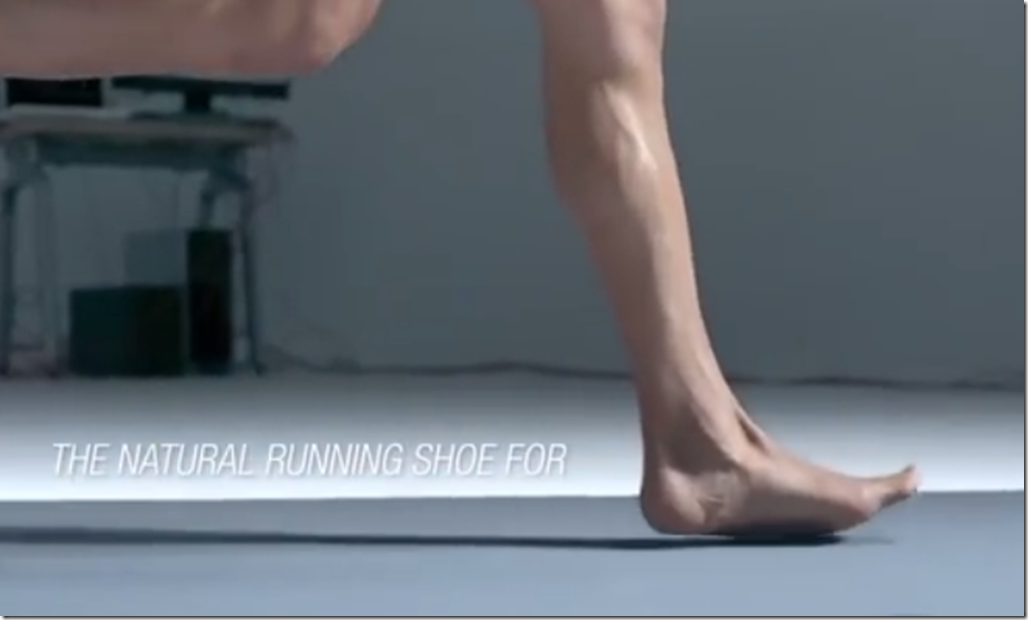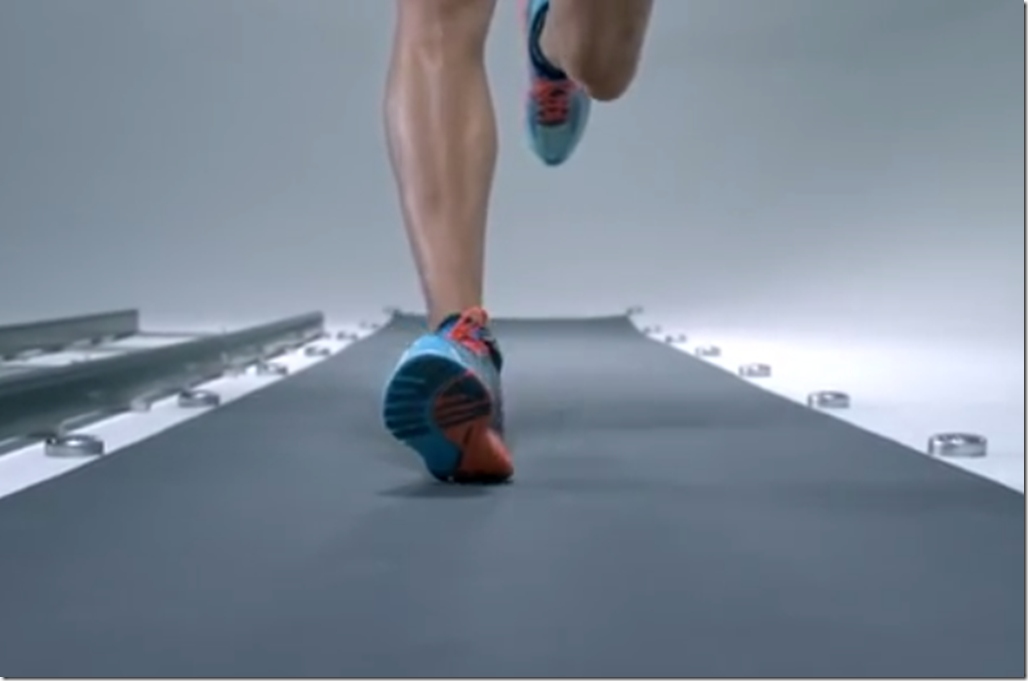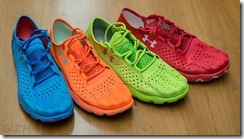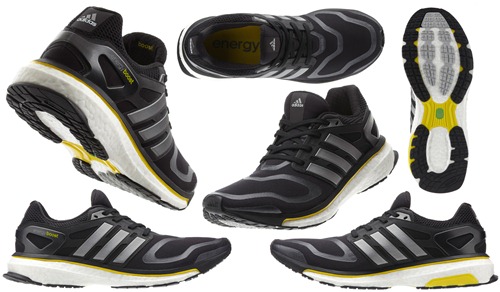Runblogger Forum member Michael recently posted a video from Asics that features the Asics Super J33 running shoe. The Super J33 is kind of the stability version of the Gel Lyte33, a shoe that I like a lot. I bought the Super J33 as well for a review, but have not had a chance to run in them (this winter has killed my road shoe miles).
Have a look at the video:
The video is interesting in that it compares a guy running both barefoot and in the Super J33 shoes on a lab trackway. Asics describes the shoe as a “natural running shoe for overpronators” and makes claims about 45% of runners being overpronators and how overpronating can put more stress on muscles and ligaments. When I see claims like this about overpronation, my immediate reaction is to reference this excellent post by podiatrist Ian Griffiths, who writes:
“…the term ‘overpronation’ is neither accurate, descriptive nor meaningful, and should therefore be erased from modern day usage in both the lay and the medical communities.”
I agree.
I guess this shoe allows you to run naturally minus that nasty overpronation, which really needs to be corrected so that you run a bit less naturally.
Oh, and the shoe also apparently changes your natural foot strike as well (assuming by natural running they mean running like you do when you’re barefoot):
In actuality, the video is pretty cool in that it shows how things can in fact change when you go from barefoot to shod, and that shoes do influence gait. It does also seem like the runner pronates less when in the shoe (hard to tell without using bone pins since estimates of eversion based on external markers are unreliable), but I’d ask if that’s necessarily a good thing?
I’m not opposed to the idea of a stabillity shoe, and I do think that reducing pronation can be a positive thing in managing certain injuries (particularly if the shoe is causing the excessive pronation). My guess is that I’ll like running in the Super J33. But as Ian Griffiths always likes to point out, overpronation is not a diagnosis. It is not something that must be controlled at all costs. Sometimes controlling how the body wants to move can be just as problematic as trying to make it move the way we think it should. I’d hoped we’d moved beyond this with the science that has come out over the past several years, but apparently not. The battle rages on…



















Hey, I’m surprised to see you post this again. I’m starting to feel like a crazy old coot running in the snow in my toe socks and Altra Adams, and always going on about natural running. When the natural running store nearby proudly started selling the new Transcend by Brooks, I really knew things had changed.
I still believe that running minimal is a great option, and should always been one of the options on the table. Might be the full-time option for some, or even a one a week mix-it-up kind of option for others.
Well, exactly.
When I figured out the game these guys are playing a few years ago, it made me very negative about brands like Asics.
I went for a gait analysis and was told I’d gone from being an over-pronator (how terrible!) to a neutral runner. And I remember thinking that a) all these running companies had been telling me that that was impossible and b) when I looked at the gait analysis I could see exactly what was happening – I’d started to land midfoot with my foot moving backwards when it landed so the pronation essentially became invisible and irrelevant.
I don’t expect all these companies to become Inov8 or Newton overnight, and maybe they need to tell these watered down lies for a bit longer, but you can’t help thinking they now understand the problem but refuse to address it directly for fear of undermining all their silly expensive fat Kayano-type shoes.
Well done to companies like Brooks and Sketchers (never thought I’d say that) for being more honest.
Well, Brooks did just release the Transcend with its “guide rails.”
Just watched the video again – that guy looks way more comfortable without the shoes!
How can you tell? Did you ask him?
Or are you more comfortable without shoes than with (which is totally fine if you are…)
As to the Super J33 specifically, incredibly pointy toe and offensively stiff medial heel support. Stay away, no one’s feet are shaped like this.
I second what Sam is saying. I have used some Asics shoes in the past and really liked them (e.g. Hyperspeed 4s felt great, Fuji racers great for mixed trail/road runs, and Piranha are still my favorite 5k/10k race shoe). I’ve been struggling with metatarsalgia and decided to try the Super J33 and just like Sam I found these to be the most bizarre, pointy shaped shoes I’ve ever seen. Certainly they are NOT the shape of any human foot. And they made my feet hurt even worse. Just a complete non-starter…
Looks like a great advert for not wearing shoes, runner looks pretty reasonable without them.
Is this advert really about trying to sell that natural mechanics aren’t healthy so… we need their shoes to fix the non-existent “problem” that only dubious marketing has created.
Seems that way.
Thanks for sharing this. Awesome quality video shoot with mediocre info in it.
My thoughts on pronation: we’ve all run to the point of fatigue/breakdown. In my clinical and laboratory experience, this is when many runners get injured. The dreaded “overuse” injury. While I think we all agree that strengthening is a valuable way to prevent this breakdown, shoes have been shown to help OR hurt this process, depending on the shoe.
A shoe isn’t as important to me when you are fresh/strong. What is more important is what does the shoe do for you when you break down. That support/motion control/pronation control can help a lot of runners from putting added strain on their body when they break down.
Peter– I’d love to have you share your thoughts on “re-supination” at terminal stance. Seems to us that many people are confusing pronation (which is good) with the inability to resupinate at push off (which is great). Seems to me that resupination is the type of “motion control” most people need…
I don’t think I’ve run to the point where my form has broken down. I’ve spent a great deal of time minimal/barefoot to really get the hang of good form. I took a day off after my last marathon in November, which was my 5th marathon since the previous April. I still seem to be injury-free. Oh, and I’m a pretty crappy runner too, actually.
Some people look like they’re broken down the minute they start running. I wonder if these people are the majority of those getting injured, and if they would benefit from a little barefoot practice and attention to form.
This is so true: “Some people look like they’re broken down the minute they start running.” Well said.
I think some proprioception training barefoot is valuable for most runners, but we’re even bigger fans of doing drills before every run. Golfers do drills, Basketball Players do drills, and Pianists do drills–all for proper technique. Don’t see many runners doing them…
I would agree that resupination can be a problem, it’s something I’ve been thinking about a lot lately as it relates to shoes with a soft forefoot (e.g., Nike Pegasus). My right foot does not resupinate as well as my left, and I see this manifest in the form of more prominent calluses along my right big toe and ball. Some shoes this effect is much more pronounced than others. I think this is why I like a shoe with a softish heel but a firm forefoot.
Unfortunately, despite the efforts of folks like Ian Griffiths and Pete, the pseudoscience of “diagnosis-by-pronation” is still very much in practice in retail outlets as well as popular publications like Runners World. It almost feels like there’s too much marketing muscle and institutional inertia behind ideas like “overpronation” and “motion control” for reason and science to overcome.
Yes, and it drives me nuts!
Me too!!
Keep fighting the good fight Ian!
and me..
I find this quite amusing coming from the shoe company that refused to drop below 10mm for the heel-toe-offset for the longest time and had marketing on sites like three point five to the effect of there is no research to suggest shoes below 10mm are better. Chasing trends continues for all brands. On a positive note, good high resolution video of gait and how a shoe can impact gait. Love the Griffiths quote.
While I agree with your ideas on minimalist running, I used call myself an overpronator and I happen to love these shoes :-) So either this is pure chance, or there’s something there nevertheless. Anyway, I’ve decided to put the running experience before the marketing campaigns.
An interesting discussion and good post Pete.. the point perhaps not being made loud enough, and I am sure this is what Griff is driving at, is that pronation per se does not matter at all, and as we know, it is completely normal. What does matter is when a normal motion, pronation at the subtalar joint, happens in an abnormal time frame. STJ pronation is essential in normal gait from heel contact (can we please assume for the sake of this discussion there is heel contact!!), until about 40% of the stance phase of gait. The foot must then begin to supinate to allow the joints of the foot to close pack, thereby allowing a more rigid structure and stable platform for propulsion. So we have 2 cycles of normalcy, first pronation, then supination, and hopefully supinated at take off. The entire proximal kinetic chain, think ankle, knee, hip, pelvis and back and ALL the muscles that work with these structures are dependent upon the TIMING of these events being ‘in sequence”. When this does not occur, for example if a foot is pronating.. even a little bit during late midstance and into propulsion, asynchrony of events occurs and the window for a problem opens. I know a bit about the Super J.. and I know a bit about the original intent and how that might be achieved, and it seems that once more big companies have allowed marketing to get in the way. Some people do have problems with the timing of pronation, and these people may be more susceptible to some injuries.. these are the athletes incorrectly and illogically labelled ‘overpronators’. It should be possible to offer these runners a lightweight and flexible shoe, not defined by features that do not work.. dual density midsoles, very stiff midsole/outsole combo, rigid shank, stiff heel counter blah blah.., that helps to establish a degree of timing to the events of gait that are so important. Whether this shoe has achieve that… time will tell.
I agree Simon. I think looking at things like initial pronation velocity as it is affected by heel firmness, sole flare, etc. is important. I also think that looking at things like caving of the midsole at the medial forefoot as the foot pronates and how it influences resupination is important. And I think excessive pronation can be something we might want to modify in some injuries.
But what I think we also agree on is that assigning someone a shoe from a particular category based on what the arch looks like or based on a subjective assessment of a rear video of the feet (or worse, by eyeballing it) is a dead paradigm. Marketing has a way of twisting and misusing science to sell shoes, and that’s not a good thing. Pronation has almost been used as a scare tactic to sell shoes, and that has to stop.
yep.. that duck was dead in the water years ago.. time for a major revamp of the whole story.. some facts and a bit of science would not go at all astray!
set the stage. i’m 6-3/225/56. sie 14 (wear 15 in most shoes). started running/weight loss at 380 3 years ago. the stores stuck me with adrenaline’s. they said “here, you’re a big guy, plus it’s the only 15 we stock, you ovrpronate and need it”. what? they barely watched me walk! ff to recently. they still are pushing medial posts at me. i despise those things. the make me unstable just trying to stand still in them. i have a pair of skechers go bionic trail (14 is a perfect fit, they must run large…do all skechers? i’d love to buy more). also, a store has a device you stand on, it looks at your arch, tells other characteristics, etc. the clerk said it told him that i have “average arches and pronate, and that i should NEVER get below and adrenaline, well maybe a ravenna to see how it works, but NOTHING less, stay completely away from anything lower drop, etc. I also have a pair of Altra Torin’s (the 15 is a little tight, but should be ok). Love those shoes as well. Also, the Merrell Bare Access 2 I tried on in 14 fit perfectly. I love the lower-zero drop shoes! Now, if Newton would come down in price, I REALLY want to try them. My goal this year is midfoot striking and form in addition to over 100 racing miles (had 169 last year). BJ
Thanks for the comment BJ! Those arch scanners are complete BSand have been debunked by science. Any store using them to assign running shoes with such certainty is not doing its job. Glad you have found what works!
As for Newton, check the clearance selection at Running Warehouse.
Pete did you ever put many miles on these shoes? I was considering a pair (a little disheartened on reading these comments…) and would be interested to know what you thought of them. I have a final end-of-clearance pair of Kinvara2 that I need to admit are about to die, and I am looking for a replacement – I had hoped to try the Fastwitch6 but none of my local stores stock it and I’m nervous about ordering from abroad without trying first. I have a pair of NB 890v3 which are okay but they don’t feel fast and fun like the Kinvara to me…
Scrap that, just found a pair of Super J to try on at a local store, no way I’m buying those…
Pretty ugly shoe!
I bought a pair but honestly have not run in them. I think they are going to go on Ebay unused.
Pete,
Did you end up running in them or not ? IF you didn’t… why ? It seems like a nice shoe… probably for similar audience as the Kinvara ?
I did not, the fit was way too narrow on my feet.
While I am late to find this post, I can’t help but comment anyway. Over the past few years I have been constantly tweaking and experimenting with my running mechanics. The conclusion that I have come to is that running completely barefoot is the most comfortable and injury free way for me to run (as of now).
I ran track in high school and I wore traditional running shoes with arch support because like many others I considered myself to “over-pronate.” These running shoes did “correct” my over-pronation as they were advertised, but I still wouldn’t have considered myself injury free. I experienced pain in my knees and plantar fasciitis that wasn’t incapacitating, but that never seemed to go away and I grew to believe that pain was just a part of running.
I agree that the foot type that over-pronates, or in other words “pes planus,” is a perfectly healthy foot type in my opinion. I myself am a relatively tall and perhaps lanky individual, but I have always been athletic and well coordinated, and people who are tall and lanky seem to also have long feet (in fitting proportion to the rest of their body) which predisposes them to “over-pronation.” When comparing example images of feet that are “pes planus,” versus those that are “pes cavus” (arched to a great a degree), the “pes cavus” feet immediately appear to be unattractive and disfigured, while the “pes planus” appear healthy, well-formed, and attractive on an aesthetic level. This perceived fitness of “pes planus” feet would make sense given the large percent of the population with “flat feet.” Suppositionally allow me to venture that all people, not limited to just specialists or doctors, have the ability to accurately judge the fitness or attractiveness of other people for the purpose of one day selecting an attractive mate, and this is profound because it implies that “flat feet” must have been chosen by our ancestors through natural selection as being desirable, and ultimately there must be some functional reason or advantage that explains why we have “flat feet.”
The problem, and subject of great controversy, with traditional running shoes is that I find that they do not allow for full activation of the windlass mechanism. The windlass mechanism is so important for people with flat feet because it brings the foot into a rigid tight-locked position, which then acts as a lever arm and effortlessly supports the entire wight of the body. If the windlass mechanism is not engaged, and the arch remains flat and pronated as the foot propels the body off the ground a tremendous stress is placed on the plantar fascia. The shape of the mid-sole of shoes with arch support creates an artificial arch by forcing the foot to constantly be in an arched position, and while this may alleviate plantar fasciitis, it is problematic because the shape of the arch eventually wears down which then requires the purchase of another pair of shoes, and it creates an un-ideal position for the foot to land. When the foot lands while running barefoot it is actually supposed to be flexible and pronated in order to absorb shock, so in order to compensate for this the bottom of running shoes is very heavily padded, which is not completely effective because so many runners still have knee problems from excessive shock, and because the plantar fascia of the constantly arched foot is always in a lax position, it never has the opportunity to become strengthened by small amounts of repeated stress like that which occurs during barefoot running. This also explains why the transition form shoes to barefoot often takes relatively long because the runner needs to gradually strengthen and develop their plantar fascia. Essentially, when running barefoot the foot is both pronated when landing, and then supinated as it propels you of the ground, as compared to the single position it is constrained to when running in shoes. Additionally the padding of running shoes has given birth to the unique phenomena of the “heel-strike” which seems like a completely detrimental habit in my opinion and is impossible to do while running barefoot because it would be too painful.
I have tried running in nearly all types of footwear. I recently bought a pair of Vibram five fingers, but, like traditional shoes, they too limited my range of motion to a degree that was uncomfortable. I have also tried making my own huarache style sandals, which were essentially a thin strip of rubber secured to my foot by a shoe lace. These did allow my foot the same degree of movement as barefoot running but they made an obnoxious clapping sound when running in the neighborhood. Barefoot running however has been completely discrete, pain-free, and much more enjoyable than every other option. Only running barefoot on soft grass is a misconception and I enjoy to run on all types of surfaces and I prefer smooth road or sidewalk. I have been running barefoot for nearly a year now and I have no complaints. I believe that the reason shoes still persist and barefoot hasn’t become mainstream is because shoe companies want to continue making a profit by selling expensive running shoes. Take what I say with a grain of salt, I am no expert however, I have just been very interested in running, and have done many hours of personal research online, and I couldn’t help but give my two cents worth.